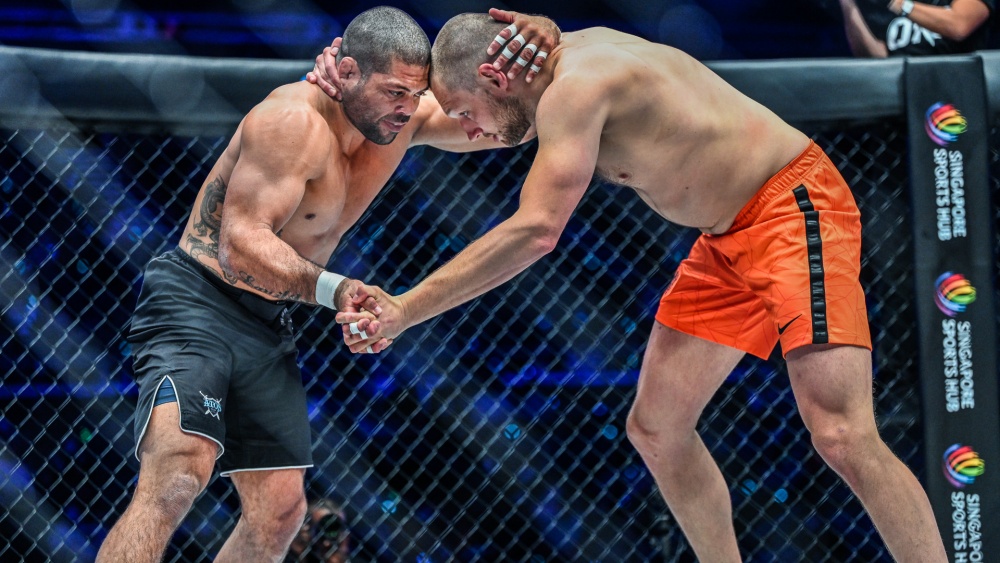10 Attacks From The Overtie Position In MMA

Guest post by Evolve MMA, Asia’s premier championship brand for martial arts with the most number of World Champions on the planet. Named as the #1 ranked martial arts organization in Asia by CNN, Yahoo! Sports, FOX Sports, and more, Evolve MMA is the best gym to learn MMA in Singapore.
Fighters often find themselves in the overtie position in mixed martial arts and grappling-based fighting styles like Brazilian Jiu-Jitsu and Wrestling. Two combatants are in the overtie position when both fighters have one hand on the back of their opponent’s neck on the same side.
The overtie is generally viewed as a 50/50 position, but you can make it an advantageous position by learning a handful of attacks you can execute from it. You’re going to find yourself clinched up in the overtie position from time to time in mixed martial arts, so you might as well get comfortable with it.
Ten Effective Attacks You Can Launch From The Overtie Position In Mixed Martial Arts
Ready to improve your ability to fight out of the overtie position? Let’s go over some effective techniques you should consider adding to your fighting arsenal:
1) Overtie To Single-Leg Takedown
Here’s an easy way to transition from the overtie to a single-leg takedown. From the overtie, slide backward and pull your opponent’s head downward to disrupt their balance, then clear their hand off your shoulder as you shoot in for a single leg on the same side. Finish the single leg like you would normally do by pivoting and using your head to drive your opponent to the canvas.
2) Overtie Slide-By
The overtie slide-by is an effective technique when you’re dealing with an aggressive opponent in the overtie who’s constantly pushing on you. As was the case with the single leg, the first thing you want to do is break your opponent’s posture by pulling down on their neck.
You then drag your opponent forward by pulling on them, while sliding back behind their back simultaneously. Make sure you control the hand your opponent has on your neck while doing this by grabbing it above the elbow. This prevents your opponent from getting you with a single leg while you execute the technique.
When done properly, you end up taking your opponent’s back, a significantly more advantageous position.
3) Overtie To Double Leg Takedown
Executing a double leg from the overtie requires you to get your opponent to raise their head so you’re in a position to shoot for the takedown. A simple way to do this is by constantly pulling down on their neck to get their head down with your collar tie. This often leads to your opponent raising their posture to prevent you from lowering their head. That’s when you shoot in for the double-leg takedown.
You won’t be executing a traditional double leg from this position, instead, you grab their ankle with your near hand, while you attack their leg with your other hand. You then drive forward and around your opponent’s far leg to finish the takedown. If you fail, you can always go for a low single leg.
4) Overtie Arm Drag
You can take your opponent’s back from the overtie position by dragging their attacking arm across their chest and sliding behind to take their back. From there, you can look for the back mount and attack with submissions like the rear naked choke or drag your opponent to the canvas to take the top position.
If your opponent manages to spin with you as you attempt to take their back, you can follow up with a low-single.
5) Overtie To Ankle Pick
The overtie position also puts you in place to pick your opponent’s far foot. From the overtie, grab your opponent’s free arm with your free hand and control it. Switch stances so your far foot is your lead foot and drop down to your far knee as you snap your opponent down.
Let go of your opponent’s free hand once you’re on your knee and grab the back of their ankle. Pull their ankle toward you while pushing them back with your other hand to complete the takedown.
6) Overtie To Near-Foot Sweep
Here’s another effective takedown you can execute from the overtie position. The first thing you want to do is to establish a grip so grip which supports your overtie hand that is on your opponent’s neck.
Step outside as you pull your opponent with both arms and sweep their near-foot with your far leg to get them on the canvas. You don’t use much energy when this technique is executed properly.
7) Overtie Slide-By To High Crotch
From the overtie position, pull your opponent diagonally toward your near side and immediately shoot in for the high crotch. You can make things easier for yourself by getting your opponent to move toward your near side by pushing them in the opposite direction.
Shoot as deep as you can when going for the high crotch and finish it as you normally would. When done properly, your opponent doesn’t have any choice but to go for a ride.
8) Overtie Snap To Low Single
This technique involves dragging your opponent’s right hand to open up offensive options. If your opponent reacts poorly to your attack, you might have an opportunity to take their back. If your opponent defends against the arm drag correctly and turns around to face you, shoot in for a low single leg and grab a hold of the back of their ankles.
9) Overtie To Fireman’s Carry
Try to establish a collar tie, have your hands on your opponent’s neck, and keep your head on their shoulder. Next, drop his head with your hand that is on his neck and level change. Grab his thigh and have him in the fireman carry position. From there, you can finish the fireman’s carry by dumping them over your shoulders.
10) Reverse Arm Drag From Overtie
Here’s a nice technique to have in your tool kit if your opponent keeps defending effectively against your arm drags from the overtie position. Grab your opponent’s near wrist with your near hand, and use your other hard to swim underneath and hook the top part of the arm you’re grabbing. Follow up by pivoting to the outside while dragging your opponent with your far arm to take their back.






